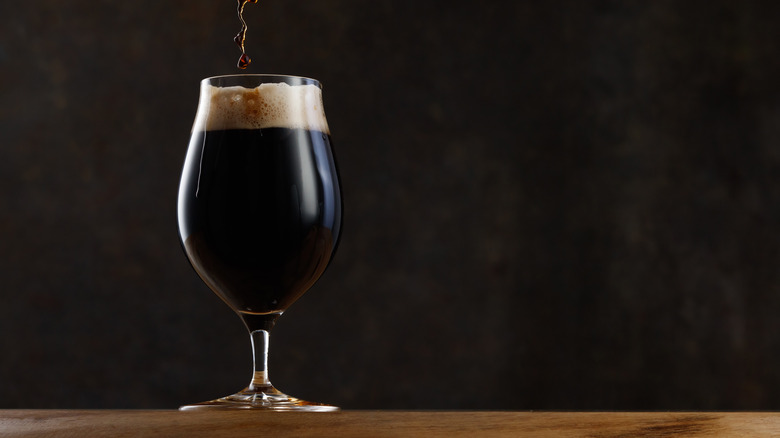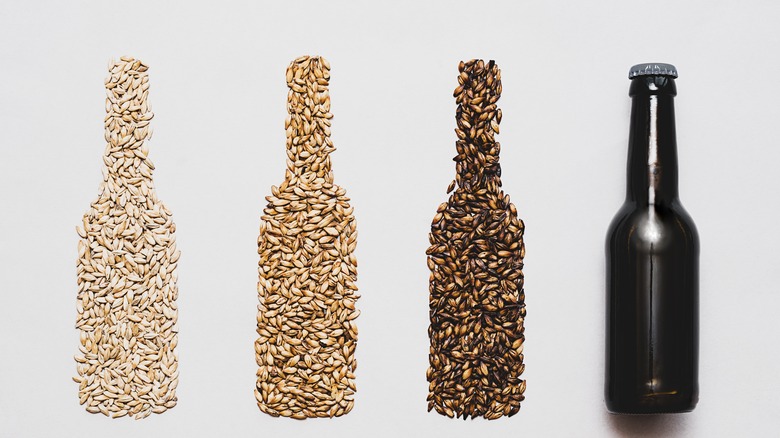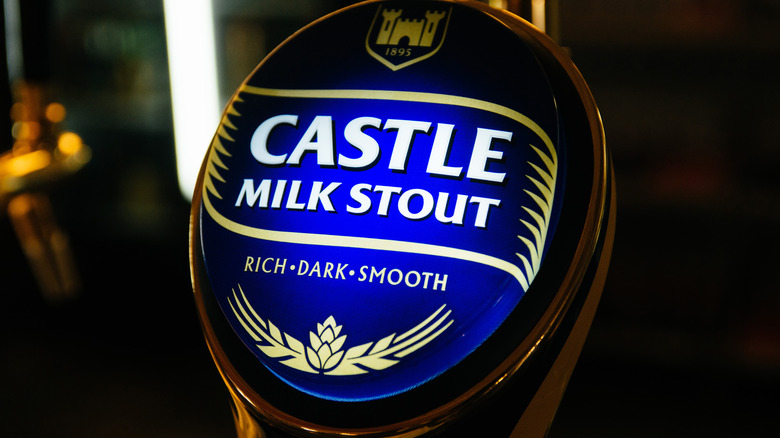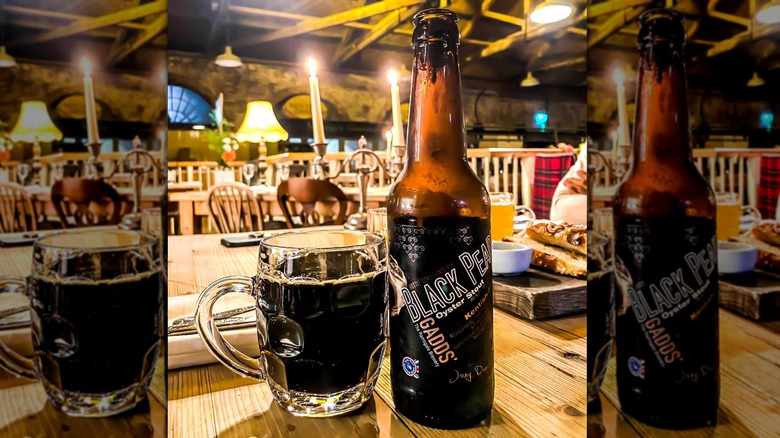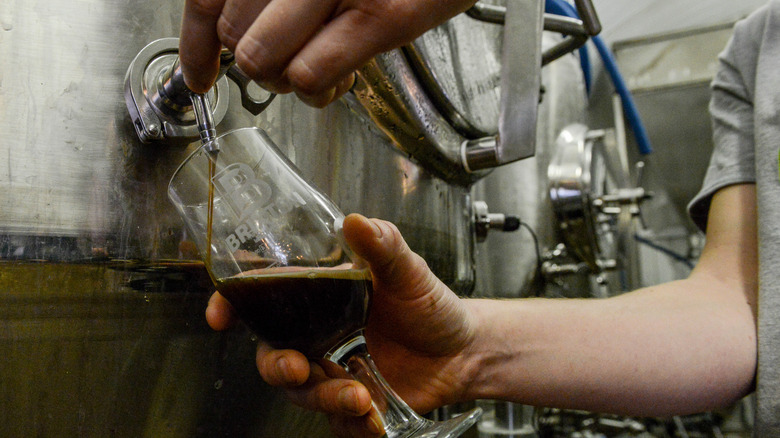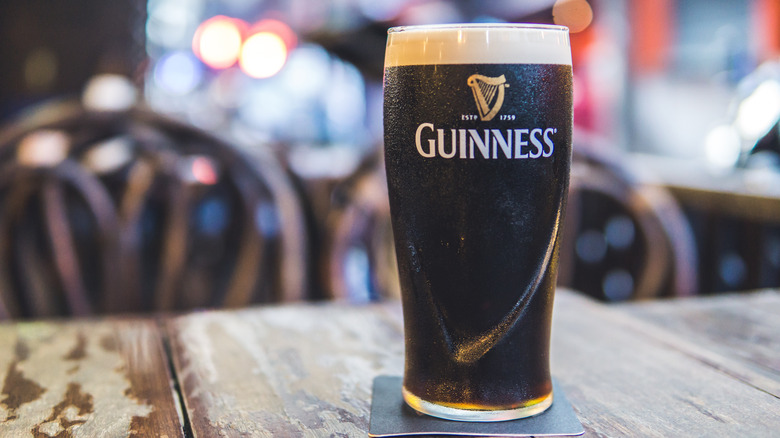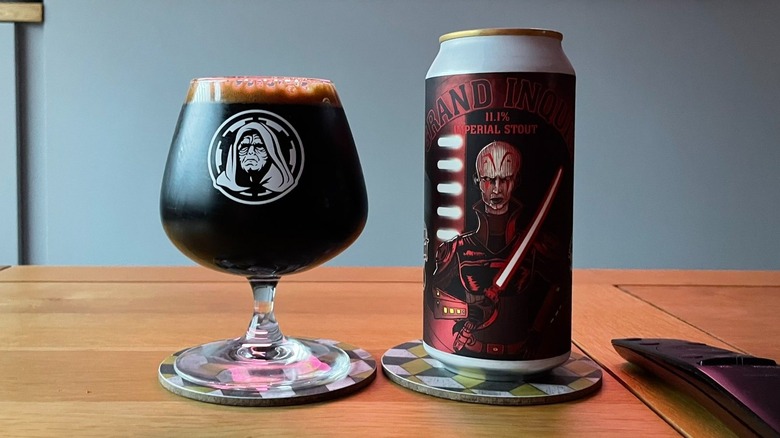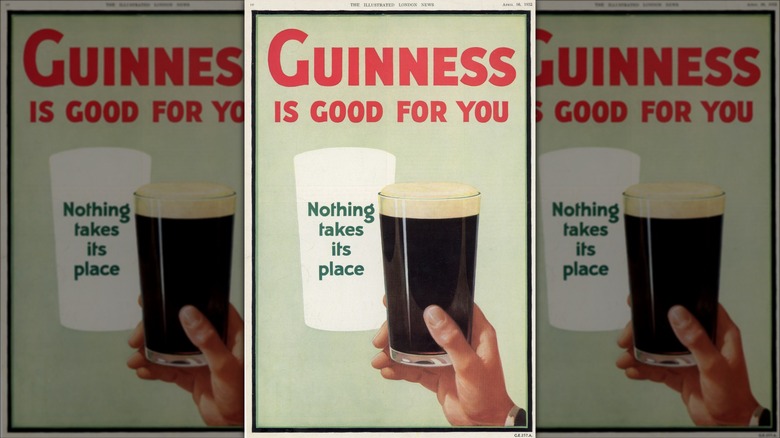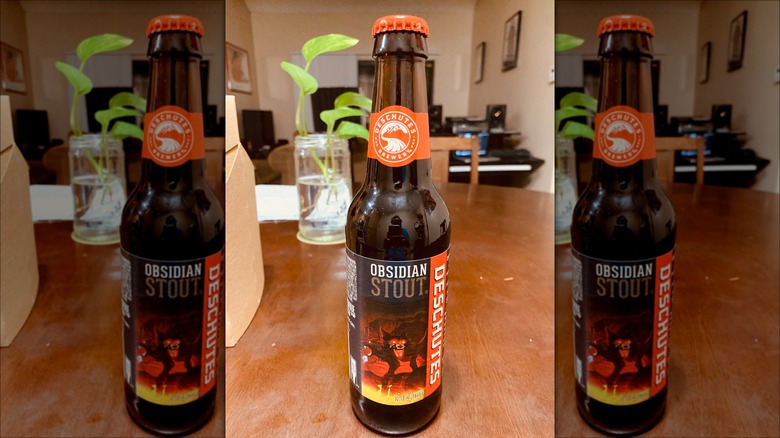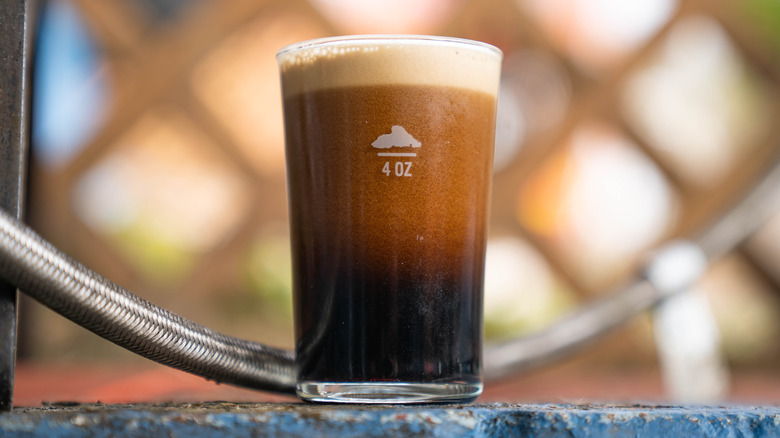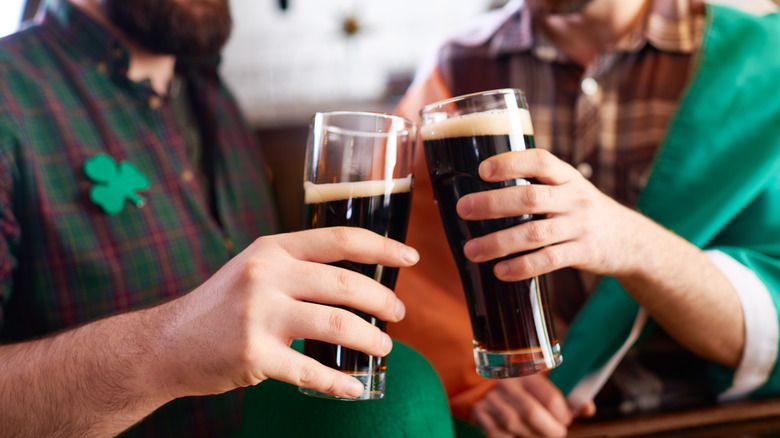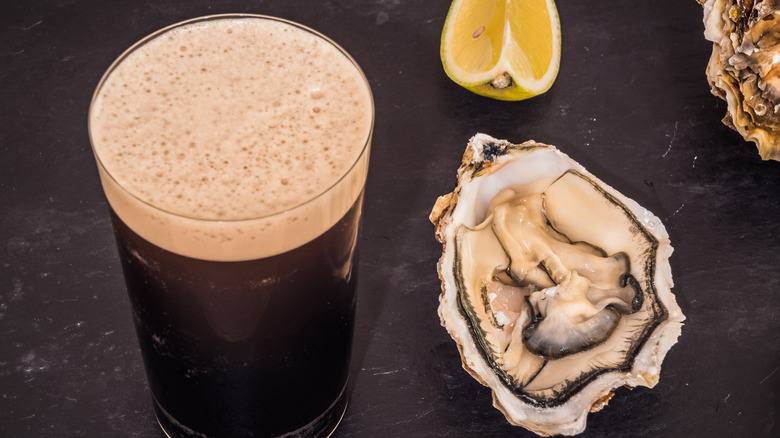A Beginner's Guide To Stout
There are many types of beer in the world. Stout is not the most glamorous of them, nor the most popular. Yet this dark beer style has endured, surviving years of falling demand to ride the wave of a recent resurgence in popularity.
Of course, stout is always popular on St. Patrick's Day, when an estimated 13 million pints of Guinness, a beer company known for its stout, are drunk globally. But stout's recent revival took hold of the city of London for more than just this one holiday. During 2022, one out of every 10 beers poured in its pubs was stout, according to What's Brewing.
But being familiar with the popularity of stout, or Guinness in particular, is not everything there is to know about stout. Enjoyable as it is, Guinness does not define stout, much as Budweiser does not define lager, or Woodford Reserve bourbon. Instead of a singular beer, stout is defined by plurality; it contains a variety of flavors, textures, and aromas that all come together thanks to their shared history. It's a beer style that deserves closer inspection.
Stout arose from porter
In the 1700s, a new beer type quickly rose to prominence in London. This beer was immensely popular with the capital's street porters: workers who helped transport shipments throughout the city. These porters valued the new beer's strong flavor, ability to keep for long periods, and cheap price. Thus, the beer was named after them.
The massive demand for porters led many breweries to create a range of them. To differentiate between the different porter styles, brewers named the strongest of them stout porters. These beers were about 7 to 8% alcohol. Over time, the term was shortened to simply stout. As a result of World War One, the production of stout was greatly reduced in the United Kingdom. During this time, Ireland became the beer's main producer. Throughout the years to come, the alcoholic content of stout was reduced.
Differentiating between stout and porter today is a difficult business, as the beers are so similar. But porters can be lighter and have a lower ABV than stouts, as well as having a slightly different flavor, as professional brewer Carston Haney explained to Craft Beer and Brewing: "I generally think of porters as being lighter in body and alcohol than stouts, with more of a chocolate character coming from highly kilned malted barley. Stouts tend to be heavier in body with more of a focus on coffee and roasted flavors from roasted barley or black malt."
There are many different types of stout
Today, the term stout encompasses a wide range of beers. One of the most prominent types of these is milk stout. These are stouts that include lactose, a sugar found in milk. This gives the beer a sweetness and freshness that consumers find appealing.
Another popular type of stout is oatmeal stout. As the name suggests, these are stouts that include oats during the brewing process. Unlike milk stouts, oats do not change the flavor of an oatmeal stout. Instead, the oats alter the texture, transforming the beer into something that is incredibly silky. This texture was described by brewer Matt Lincecum to Hop Culture: "An oatmeal stout is a stout with a great body...has all the rounded edges finely sanded down. What I'm looking for specifically with oats is the mouthfeel, a little sweetness as a contribution from the grain, and that's it."
The one type of stout most people have tried is a dry stout, sometimes known as Irish-style stout. Dry stout includes the addition of roasted barley which lends the beer a distinct flavor. The roasted barley is typically balanced out through the presence of hops, which add bitterness. This flavor profile will be familiar to anyone who has enjoyed a pint of Guinness.
Some stouts are made with oysters
The combination of oysters and stout is a tried and tested one. In the 19th and 20th centuries, oysters were a cheap and plentiful food eaten by the working classes. They were often served alongside a porter or stout in alehouses. By the mid-20th century, however, oysters had become scarce and therefore expensive. This meant workers could no longer wolf them down alongside their favorite beer.
Fortunately, brewers discovered a way of infusing stouts with the flavor of oysters. This is done by adding oyster shells during the boil. The shells give the beer a briny kick that compliments most stouts, as highlighted by LeAnn Darland, co-founder of craft beer company Talea, to Forbes: "Some say that oyster shells were added to stouts because of the soluble calcium they contribute; others say the shells acted as a clarifying agent when others weren't available. What we know is that the slight brininess and minerality you get from adding oyster shells in the wort perfectly complement the restrained, roasty character of a stout."
The brewing process gives it a unique color and flavor
Stout's defining features — the color and flavor of the beverage — arise from the brewing process. This begins with malted barley that is crushed and then heated in water. The mixture is then mashed and separated resulting in a sweet liquid known as wort. Flavorings, such as oyster shells or dark roasted barley, are then added and the mixture is brought to a boil. Much of stout's flavor and the majority of its dark color is due to the use of roasted grain during the process. At this point, hops are also added.
Once cool, yeast is introduced to the beer and it is left to ferment. It does this in a process called top fermentation in which the majority of yeast rise to the top of the wort. After two to four days, the beer has fermented and is taken away to mature. This is when the individual flavors marry together to form a stout that customers recognize and love.
The famous beer brand Guinness is known for its stout
Thanks to Guinness, stout is at once celebrated and overlooked; the brand is so popular that it is simultaneously the first and last stout many people drink. A lot of drinkers aren't even aware that Guinness is stout at all. This is down to the brand's world-leading marketing, as advertiser Steven Grasse explained to Wine Enthusiast: "Guinness does a great job of being an old, massive brand that still maintains authenticity. [The brand] rarely talks about their liquid, and when they do, it's more to say, 'Hey, we don't sell stout. We sell Guinness.' In that way, they literally don't even allow themselves to have a competitor."
Guinness has become more than just the market-leading stout. It's now one of the biggest beer makers in the world, selling 1.5 billion pints annually. A recent YouGov poll even named it the most popular beer in the United States.
This brand has been so successful due to its ability to tap into global markets. Africa is a key example of this, as Nigeria is the second biggest consumer of Guinness in the world, and Cameroon is the fifth. Both boast their own Guinness breweries that produce a beer called Guinness Extra Foreign Stout. This beer is brewed with local maize or sorghum and has a higher ABV than regular Guinness.
Imperial stout was originally made for export to Russia
Imperial stout, a strong version of the beer, earned its name through monarchical associations. This came from its connections to Russian royalty, an unlikely connection that began when Tsar Peter the Great visited England in 1698. During this visit, the Tsar developed a taste for England's burgeoning porter and stout scene. Upon his return to Russia, the Tsar requested some of this beer be shipped over.
Sending beer over a thousand miles away was no easy feat during this time. In order for the beer not to spoil, the brewers had to significantly increase the alcoholic content of the stout and the amount of hops it was brewed with. Russian royalty approved, and Imperial stout was enjoyed during both Peter the Great's reign and that of Empress Catherine the Great. This led to Imperial stout becoming the strongest and most flavorful stout. Today, Imperial stouts have an ABV of between 8 to 12%.
Despite its texture, stout can be low in calories
If you order a pint of stout in the U.K., you might encounter the quip: "It's a meal in a glass." People believe this, due to misconceptions about stout's thick texture and supposedly heavy body. Those characteristics must translate into a highly calorific beer, or so the thinking goes.
The reality is quite different. A beer's alcoholic strength contributes a great deal more to its calorific content than texture or body. Because of this, stout can actually be low in calories, when compared to other beers. For example, a pint of Guinness draught with a 4.2% ABV clocks in at 210 calories. That's around 20 calories less than a pint of Budweiser.
Of course, the number of calories present in a pint of stout varies widely, because the alcoholic content of the beers varies. Imperial stouts — which are renowned for their alcoholic content — tend to be high in calories.
It was once prescribed to breastfeeding mothers and anemic people
The slogan "Guinness is Good For You," is plastered across signs in Irish pubs around the world. Surprising as it may seem now, this sentence was once widely believed. Domhnall Marnell, a brand ambassador for Guinness, told CNN that nine out of ten consumers believed Guinness was healthy before they ever ran the ad that claimed as much.
Stouts like Guinness were even prescribed in medical settings to help new mothers lactate. This is because they contain galactagogues which stimulate the production of a hormone called prolactin. This, in turn, increases the milk supply.
The use of stouts to promote milk production is no longer advised, as Diana West, co-author of "The Breastfeeding Mother's Guide to Making More Milk," told CNN: "The problem is that alcohol temporarily inhibits the milk ejection reflex and overall milk supply, especially when ingested in large amounts, and chronic alcohol use lowers milk supply permanently. Barley can be eaten directly, or even made from commercial barley drinks, which would be less problematic than drinking beer."
In the past, stout was also given to individuals with anemia, an illness where a deficiency in iron leads to low red blood cell production. However, two pints of Guinness only equates to the iron content of one egg, suggesting there are healthier ways to boost iron levels.
American stout utilizes American hops
Never one to be left out, the U.S. has long been producing its own version of stout. American stout is set apart from other stouts through the use of American hops that are added alongside the traditional roasted malt. The use of American hops, such as Cascade, lends the beer a distinct — if mellow — taste of citrus. This compliments the toasted flavors of the malt.
Deschutes Obsidian Stout, which is made in Oregon, is a perfect example of American stout for this very reason. Beer expert Averie Swanson highlighted this to Liquor.com: "Deschutes Obsidian Stout is a classic example of an American stout—complex flavors of dark roasted coffee, chocolate, and caramel with soft background notes of black licorice and dried figs. American stouts characteristically exhibit aromas and flavors of citrus or pine resin from the use of American hops, and this beer integrates those hop flavors seamlessly."
Many stouts are now nitro beers
Many stouts are now nitrogenated, meaning nitrogen has been dissolved in the beer. This gives the stout a superior texture, as brewer Jeffin John explained when he spoke to Brewer World: "Nitro stouts are basically stouts that are infused with nitrogen. This gives the foam of the beer a cascading effect of tiny bubbles creating a thick texture with a creamy mouthfeel. Non-nitro stouts and other beers are typically more carbonated than their nitro counterparts and that's why, they tend to be fizzier in terms of mouthfeel."
Guinness was the first to use nitrogenated beers on draught. The company was also the first to create nitrogenated canned beers. Initially, these were made by placing a plastic widget in a can of beer. This maintained the pressure of the beer until it was opened and the nitrogen escaped creating the cascading effect, creamy texture, and soft head many associate with the beer style.
In the U.S., nitro beers were first championed by Left Hand Brewing in Colorado. This brewery claims to be the first craft brewery to create perfectly nitrogenated bottled beers without a widget. The brewery has used this technical know-how to sell a range of nitro stouts, many of them award-winning.
After dropping in popularity, stout is making a comeback
During the latter half of the 20th century, stouts fell out of fashion. In the U.K. during the 1980s there were only 29 breweries producing stout. Thankfully, stout has bounced back. The 2010s saw many British breweries producing their own type of stout. In 2018, stout was even named the fastest-growing beer style in the U.K.
This popularity has seen huge brands, like Theakston, adding stouts to their portfolios in recent years. Simon Theakston, joint managing director of T&R Theakston, explained the decision to launch a stout in 2023 during a conversation with The Drinks Business: "We've been in discussions with Brennan's for a while as we saw synergies between our two brands and were keen to add a traditional Irish stout to our range. This addition is coming at a time when we're seeing consumer demand for dark beers and stouts increase."
Stout is now performing well in the U.S. American stout posted healthy sales during the latter part of the 2010s. Guinness is doing so well stateside that a new brewery is about to open in Chicago.
Stout can be paired with a variety of foods
We have already seen how stouts can be paired with oysters. While an excellent combination, this is far from the extent of stout-related food and beer pairings. Other shellfish and crustaceans also prove a good match for stouts, especially those with sweet flesh, like crabs. New England chowder is also fantastic when served alongside rich, dark stouts.
Flavored stouts pair well with a variety of foods. For example, coffee stout is a well-loved accompaniment to mild blue cheese, although some believe sweeter stouts perform better in this instance. This was highlighted by cheesemaker Rachel Schaal to Culture: "With a blue, I'm looking for anything that's got a little bit of residual sweetness about it, like a milk stout...beautiful." Vanilla stouts, on the other hand, demand maximum sweetness and are great when served alongside fruity desserts.
